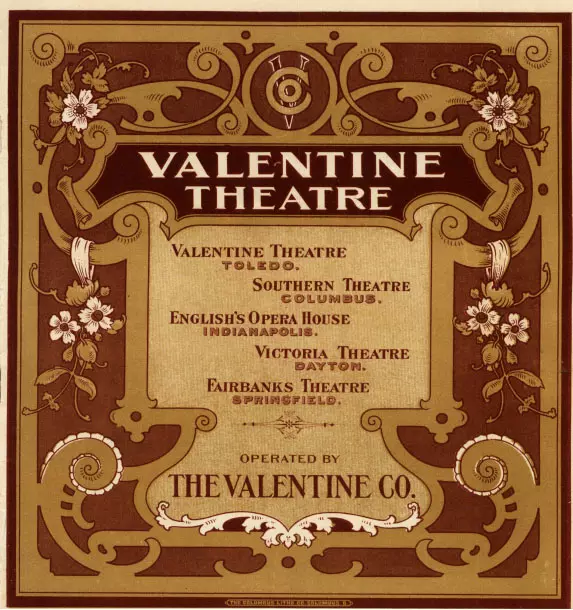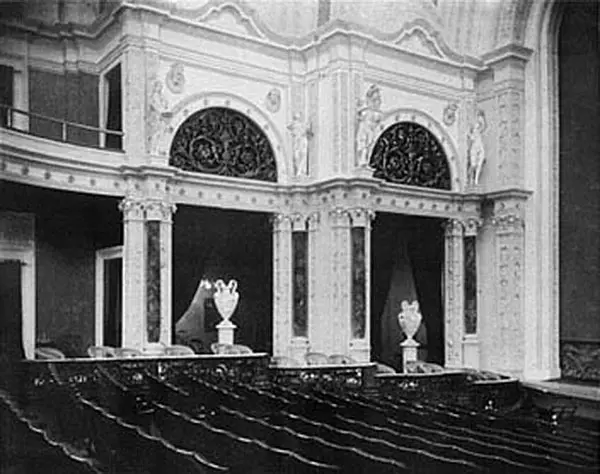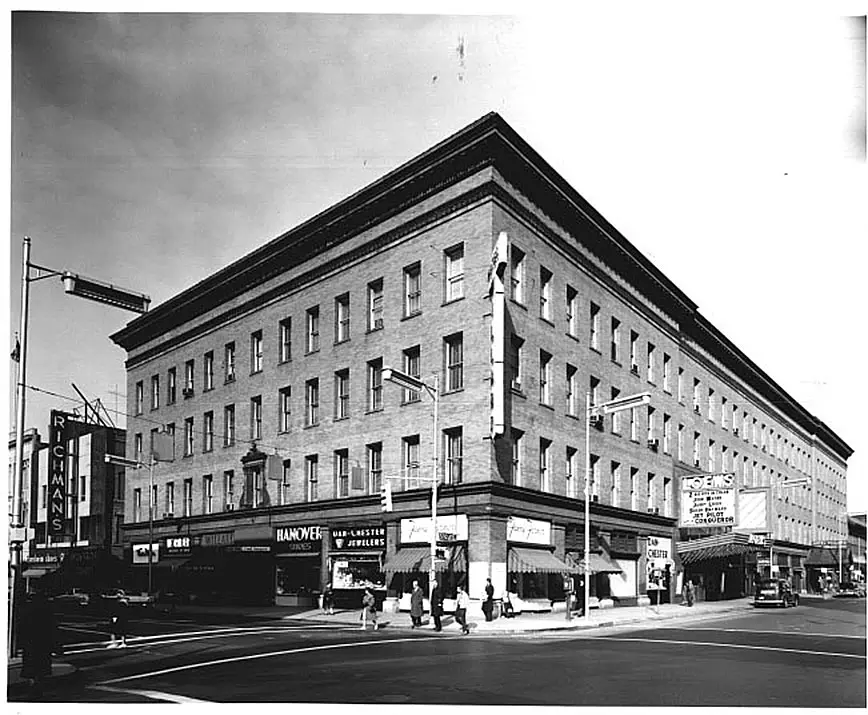 Valentine Theatre
Valentine Theatre
Exhibit Gallery
Images (in order of appearance): Original stage curtain, original theater interior, original lobby, original stage, original ticket booth, exterior view by Milton Zink (1957), and Loew's sign (all courtesy of the Toledo-Lucas County Public Library).



































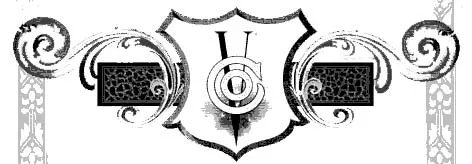 Valentine Theatre Symbol
Valentine Theatre Symbol
By Timothy Messer-Kruse, University of Toledo, 1998
In its pioneer decades, Toledo was, not surprisingly, a theatrical backwater. It was not until 1850 that Toledo built a public hall suitable for stage performances and was quickly disappointed to learn that the great singer, Jenny Lind would not travel to Toledo, even for the vast sum of $1,000 a night. By the Civil War Toledo boasted three theaters (Morris Hall, Stickney Hall, and White's Hall). Except for White's Hall, which for a few years in the early 1870s pulled in expensive name acts, none of these were particularly reputable. Stickney Hall was renamed the "Opera House" after the war and included a free drink with the price of admission. By 1875 White's had gone to vaudeville to compete with two new theaters, the Wheeler's Opera House and the Adelphi. However, even the city's workers' growing appetite for regular, inexpensive, ribald fare could not support them all. By the 1890s only Wheeler's and the new People's Theater were still in operation. Toledo's high-brow newspaper, the Blade, complained constantly about the fact that first-rate productions were offered only occasionally alongside the "trashiest kind of trash", that is, the popular farces and melodramas of the day. (Marion S. Revett, "The Old Stage Door", in Northwest Ohio Quarterly, 23:3 (Summer 1951), pp.152-157)
By the 1890s, Toledo had begun to change from a regional center of shipping and trade into a manufacturing center. The city's upper class was growing as fortunes were being made in wholesaling, oil refining, bicycles, wagon-making, glass, and machinery. When Wheeler's Opera House burned down on St. Patrick's Day in 1893, the time was right for the city's elite to build a first-class theater that would allow them to display their newfound wealth. The race was on among the city's leading capitalists to glorify themselves by building a new opera house. Wheat king, Col. Sheldon C. Reynolds was first to announce his intention to build a theater. A few months later coffee king, Alvin M. Woolson, picked out a site and hired architects for his opera palace at St. Clair and Jackson streets. But curiously, when George Ketcham, a man young enough to the grandson of either Reynolds or Woolson, announced that he planned to build an opera house at the corner of St. Clair and Adams, the older men gracefully bowed out. Perhaps the fact that Ketcham had inherited a million dollars from his father five years before scared them off - while Reynolds and Woolson arranged a syndicate to raise financing for their ventures, there was no question as to the source of Ketcham's financing. Ketcham already had a head start as the site he had chosen adjoined, and was partly surrounded by the commercial building he had begun erecting the year before. (Norma F. Stolzenbach, "Toledo Theater", in Randolph C. Downes Industrial Beginnings, (Toledo: Historical Society of Northwestern Ohio, 1954), pp.366-410)
 Exterior view by Milton Zink, 1957
Exterior view by Milton Zink, 1957
Ketcham named his new theater in honor of his father, Valentine Hicks Ketcham, son of a New York farmer who learned the trade of carpentry and ventured west in 1836 setting up a small store on St. Clair Street. His business slowly grew and by 1841 he had relocated to the better location of 32-34 Summit. But what really set him upon the path of financial success was marrying a woman whose father was the former mayor and owner of the largest dry goods business in the county. With the opening of the Miami and Erie Canal his wholesale business boomed and within in another five years Ketcham had sold the business and embarked on the more lucrative area of banking (Ketcham, Berdan & Co.). During the Civil War Ketcham's bank took over the First National Bank, with Ketcham himself assuming the presidency, and the carpenter's apprentice had climbed to the pinnacle of Toledo society. All during these decades Ketcham was shrewdly speculating in Toledo real estate at one time or another owning much of the present downtown. It is rumored Valentine may have won a large parcel of valuable land in a poker game held in Monroe, Michigan. (Blade, Oct. 3, 1999, p. 8). Whatever the truth may be, it is certain that upon his death in 1887, Valentine made each of his three children millionaires. (Harvey Scribner, Harvey Scribner, Memoirs of Lucas County and the City of Toledo (Madison, Wis., 1910), vol. 2, pp. 196-197, 390-392. (Madison, Wis., 1910), vol. 2, pp. 196-197, 390-392.)
Befitting a memorial to such a father, (and to his own social ambitions) George Ketcham was bold in the construction of his theater. He hired the city's most famous architect, Edward O. Fallis, the designer of the county courthouse who seems to have been given a very free hand. Fallis's designs included an unusual cantilevered balcony (one of the first of its kind in the United States). His floor plan broke with the common design of theatres of its day by arranging the theater's seats in straight rows rather than semicircular ones that accommodated more seats but gave some theatergoers obstructed lines of sight. To attract the highest quality entertainers, the basement was fitted with 18 elegant dressing rooms, each unusually supplied with hot water baths. And in an age when electric lights were still considered a luxury, the building was equipped with large dynamos in the basement sent direct current to 2400 incandescent lights. (Ohio Michigan Line, (Spring 1984), pp. 5-6)
Fallis and Ketcham, though bold in structural design were far more conventional in decoration. Befitting the Victorian era, the theater was awash in marble, velvet, and silk. A variety of Italianate sculptures and urns dotted the halls as did custom-made furniture in the French Empire, colonial, and Dutch styles. On either side of the proscenium were bas-relief cupids piercing a heart with the theater's signature "V" in its center. Still the building cost somewhere around $300,000, (around $6,000,000 in today's money).
The Valentine Theater opened on Christmas night, 1896 and the demand for tickets was so great that they were auctioned off (Blade, December 26, 1896). Mr. Fred J. Reynolds bought the first box for the princely sum of $250, two-thirds of the annual income of the workers who cleaned the building. (Toledo Times, May 15, 1932) The first night's curtain went up on a production of Rip Van Winkle staring the veteran actor, Joseph Jefferson.
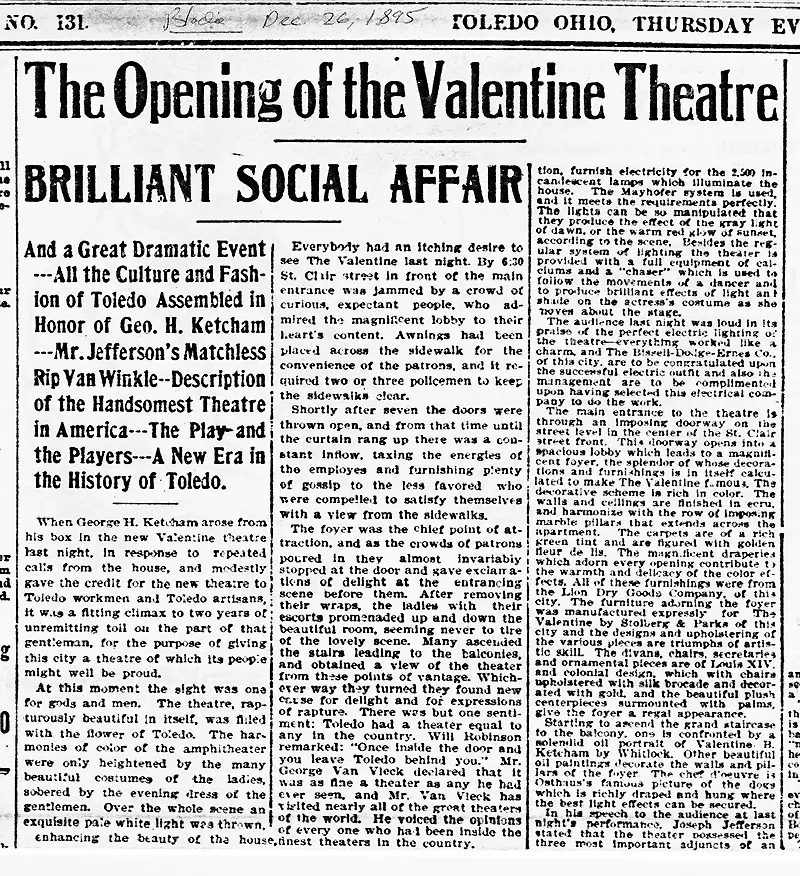 The Opening of the Valentine Theatre
The Opening of the Valentine Theatre
Ketcham had the misfortune of completing his building on the eve of the depression of the 1890s when property values stagnated and money was tight. Though Toledo kept more of an even keel than most cities in this period, it must still have been quite a windfall for Ketcham when the city council leased most of the building's second and third floors for city offices for $6,400. Ketcham was certainly grateful: after the first council meeting held in the new building, Ketcham invited all the politicos upstairs where the city engineer's offices had been turned into a lavish banquet room and the night was filled with "feasting and merry-making". One reporter noted that the "right royal night" made temporary friends of enemies, "Councilmen who seemed ready to fight while down on the floor below clinked glasses in good fellowship and never hesitated to tell each other what great men they were."
Thus did the Valentine Theater house the offices of Toledo's most famous politicians, Samuel "Golden Rule" Jones and Brand Whitlock, reformers who protested that the city's taxes were being drained away in the form of rent to one of the city's richest men. But neither Jones, nor Whitlock was ever able to convince a majority of the council to invest in a city hall and the Valentine Building would remain seat of the city's government until 1921 when rents that galloped past the $20,000 mark forced a hasty move to the newly completed safety building, a building intended to be the headquarters for the police and fire departments.(Blade, Jan. 17, 1954)
History was made at the Valentine on many occasions. It was there, in his campaign headquarters, that Jones watched the discouraging returns pour in from his failed 1899 race for the Governor's office. In 1903 hundreds of citizens crowded into the small council chambers and shouted down streetcar officials and won a municipally mandated fare reduction. The following year after Jones died, the council reversed their position and a famous citizens protest against high streetcar fares known as the 'petition in boots' (Brand Whitlock, Forty Years of It (New York: D. Appleton and Co., 1914), pp. 176-180) paraded beneath the Valentine's windows. In the wake of the controversy Jones' Independent party elected three more aldermen and swept Brand Whitlock to an easy victory.
Toledo, being a central rail hub, was a convenient stop-over for acts on their way to Chicago or points further west. This along with the Valentine's luxurious reputation combined to bring all the greats to Toledo. Over the course of its first two decades, the Valentine Theater brought to Toledo a surprising array of theatrical and musical talent. Great orators graced the stage as well, including Mark Twain, the poet James Whitcomb Riley, and the great free thinker, Robert Ingersoll. By the early years of the twentieth century, the Valentine opened up its stage to less traditional acts. Harry Houdini played there in 1906 and an exhibition basketball game was held on its stage in 1912 (the underdog Toledo Overlands beat the Detroit Athletics, 47 to 37. (Blade, Jan. 13, 19, 1912).
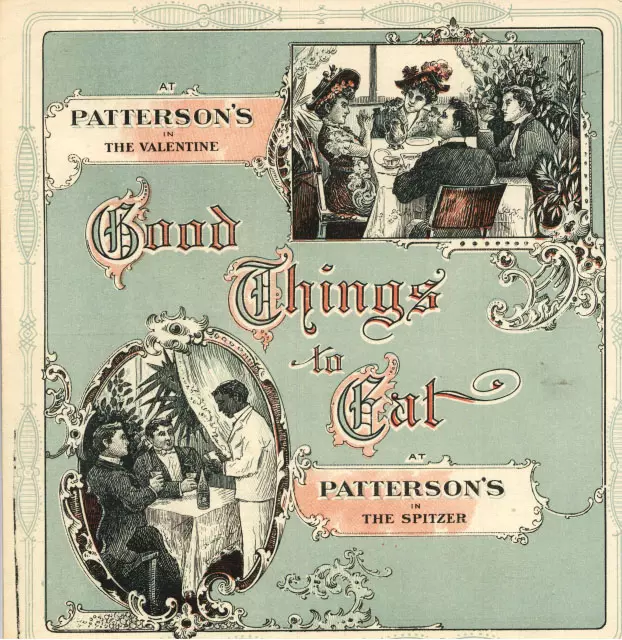 Advertisement for Valentine (formerly Patterson's) Cafe
Advertisement for Valentine (formerly Patterson's) Cafe
At its peak the Valentine was symbolized the golden age of Toledo. It housed one of the city's best restaurants, Patterson's (later known as the Valentine Cafe), a basement establishment that offered diners their choice of decors in private Dutch, Oriental, Venetian, Colonial, or German dining rooms. It was the 'society' place to go for squab en casserole, mutton chops, saute caribou, or filet mignon. In 1913, as the city boomed with the automobile and glass industries, a massive illuminated sign, 78 feet long and 68 feet high, bearing 7,000 lights and weighing 25 tons was hoisted into place on the roof of the Valentine. The animated sign could be seen for miles flashing its claim, "You Will Do Better in Toledo". (Blade, Dec. 17, 1913.)
In 1918 a screen was stretched across the stage and the Valentine doubled as a movie house. That thirty feet of sheeting signaled the end of the theatre's glory. With the depression came the demise of many touring companies and the public's escapist mania for the talkies. The Valentine's owners decided to concentrate on the movie end of the business and embarked on a $50,000 "renovation" that turned the grand opera house into a movie palace. (Blade March 13, 1932.) Most of the changes were cosmetic, except for the installation of a projection booth over the old balcony and the removal of the ticket booth from the lobby to the sidewalk. (Blade March 10, 1932. The biggest change was not inside but on the new electric sign - the old Valentine name was removed and that of a movie syndicate, "Loew's", was put up in lights.
By the 1960s, even the movie business was having trouble filling the thousand seats of Valentine and Loew's relocated its cinema to a smaller venue. Though a succession of other owners would try and make it go, the theater was finally bankrupt and shuttered in 1974. Two years later the city finally bought the building it had occupied as tenant so long before for $468,000, renaming it the Renaissance Building.
The hoped for renaissance was never happened and in August of 1983 a task force established by Mayor DeGood recommended the demolition of the Valentine as soon as possible, at a cost nearly equal to the original cost of building the building ($217,000 compared to $300,000). A campaign, spearheaded by the LCVHMS landmarks committee, architectural historian Ted Ligibel, theatre designer George Izenour, Richard Helldobler of the Toledo Ballet School, councilwoman Donna Owens, TMA curator Roger Mandle, James Hill of the University of Toledo's Theatre Department, and Rey Boezi of the Toledo Cultural Arts Center, and others, organized as the Friends of the Valentine, to save the theatre saved it from the wrecking ball. Within a month the council voted to save the theatre. (Ohio Michigan Line, (Spring 1984), p. 5; Blade, Oct. 3, 1999, p. 15.) Nearly twenty years later the dreams of these preservationists are coming true as the Valentine again prepares to open its doors after a $28 million dollar restoration.
Photo Gallery
Images (in order of appearance): Original stage curtain, original theater interior, original lobby, original stage, original ticket booth, exterior view by Milton Zink (1957), and Loew's sign (all courtesy of the Toledo-Lucas County Public Library).







Opening Night, 1896
 Blade article on the opening night at Velantine Theatre, December 26, 1895
Blade article on the opening night at Velantine Theatre, December 26, 1895
The Opening of the Valentine Theatre
Brilliant Social Affair.
And a Great Dramatic Event---All the Culture and Fashion of Toledo Assembled in Honor of Geo. H. Ketcham---Mr. Jefferson's Matchless Rip Van Winkle-Description of the Handsomest Theatre in America---The Play and the Players---A New Era in the History of Toledo.
(Thanks to Paula Ashton for transcribing this newspaper clipping.)
When George H. Ketcham arose from his box in the new Valentine theatre last night, in response to repeated calls from the house, and modestly gave the credit for the new theatre to Toledo workmen and Toledo artisans, it was a fitting climax to two years of unremitting toil on the part of that gentleman, for the purpose of giving this city a theatre of which its people might well be proud.
At this moment the sight was one for gods and men. The theatre, rapturously beautiful in itself, was filled with the flower of Toledo. The harmonies of color of the amphitheater were only heightened by the many beautiful costumes of the ladies, sobered by the evening dress of the gentlemen. Over the whole scene an exquisite pale white light was thrown, enhancing the beauty of the house and lending added charm to the loveliness of the ladies present.
Mr. Ketcham acquitted himself in his usual brilliant manner, and concluded by christening the new playhouse "The Valentine, in honor of one who is known to you all, and who, were he present with us to-night would share in the appreciation which I feel for your kindly expressions of approbation, and would join with me in wishing you all the compliments of the season." When Mr. Ketcham arose he bowed his acknowledgements and referred briefly to the work that he had begun two years ago. He declared that the reception accorded him robbed him of the power to properly express his feelings. He modestly refused, however, to take all the credit upon himself. He was proud of the fact that the theater was designed by a Toledo architect, and that the entire construction, with the exception of a few details where it was unavoidable to go outside, was the product of Toledo brains and Toledo energy. Mr. Ketcham was roundly applauded, and then the audience had a desire to hear from E.O. Fallis, the architect, who simply responded by rising.
Everybody had an itching desire to see The Valentine last night. By 6:30 St. Clair street in front of the main entrance was jammed by a crowd of curious, expectant people, who admired the magnificent lobby to their heart's content. Awnings had been placed across the sidewalk for the convenience of the patrons, and it required two or three policemen to keep the sidewalks clear.
Shortly after seven the doors were thrown open, and from that time until the curtain rang up there was a constant inflow, taxing the energies of the employees and furnishing plenty of gossip to the less favored who were compelled to satisfy themselves with a view from the sidewalks.
The foyer was the chief point of attraction, and as the crowds of patrons poured in they almost invariable stopped at the door and gave exclamations of delight at the entrancing scene before them. After removing their wraps, the ladies with their escorts promenaded up and down the beautiful room, seeming never to tire of the lovely scene. Many ascended the stairs leading to the balconies, and obtained a view of the theater from these points of vantage. Whichever way they turned they found new cause for delight and for expressions of rapture. There was but one sentiment: Toledo had a theater equal to any in the country. Will Robinson remarked: "Once inside the door and you leave Toledo behind you." Mr. George Van Vleck declared that it was as fine a theater as any he had ever seen, and Mr. Van Fleck has visited nearly all of the great theaters of the world. He voiced the opinions of every one who had been inside the finest theaters in the country.
Valentine Appointments. Description of the Foyer and Auditorium.
The realization of an ideal!
An exemplification of the beautiful!
In these two sentences can be summed up the merits of the new Valentine Theater in the construction of which unstinted expenditure of money, good taste and artistic skill are characteristic. It will stand a monument to the honored memory of the man after whom it has been named, to the energy and enterprise of George H. Ketcham and to Toledo genius.
The Valentine is in itself a standard of perfection, after which future play houses will be measured. It is the most complete and beautiful theatre west of the Alleghenies and has but few equals in the country.
While a part of the Valentine block, the theater is a separate building in itself, having an imposing entrance on St. Clair street. It is strictly fire proof. No wood or inflammable material has been used in the structural portion.
It is provided with twenty exits which furnish abundant means of escape in time of fire or panic, the exits being arranged at convenient places on every floor front or back of the curtain line.
The building is heated and ventilated with a system which provides pure air and maintains an even temperature at all times, no matter what the climatic conditions or how densely the auditorium may be crowded.
The Valentine undoubtedly has the best lighting system of any theater in America. Several large dynamos, operated in the cellar of the building, far enough removed to prevent reverberation, furnish electricity for the 2,500 candescent lamps which illuminate the house. The Mayhofer system is used, and it meets the requirements perfectly. The lights can be so manipulated that they produce the effect of the gray light of dawn, or the warm red glow of sunset, according to the scene. Besides the regular system of lighting the theater is provided with a full equipment of calciums and a "chaser" which is used to follow the movements of a dancer and to produce brilliant effects of light and shade on the actress's costume as she moves about the stage.
The audience last night was loud in its praise of the perfect electric lighting of the theater-everything worked like a charm, and The Bissell-Dodge-Ernes Co., of this city, are to be congratulated upon the successful electric outfit and also the management are to be complimented upon having selected this electrical company to do the work.
The main entrance to the theatre is through an imposing doorway on the street level in the center of the St. Clair street front. This doorway opens into a spacious lobby which leads to a magnificent foyer, the splendor of whose decorations and furnishings is in itself calculated to make The Valentine famous. The decorative scheme is rich in color. The walls and ceilings are finished in ecru, and harmonize with the row of imposing marble pillars that extends across the apartment. The carpets are of a rich green tint and are figured with golden fleur de lis. The magnificent draperies which adorn every opening contribute to the warmth and delicacy of the color effects. All of these furnishings were from the Lion Dry Goods Company, of this city. The furniture adorning the foyer was manufactured expressly for The Valentine by Stolberg & Parks of this city and the designs and upholstering of the various pieces are triumphs of artistic skill. The divans, chairs, secretaries and ornamental pieces are of Louis XIV and colonial design, which with chairs upholstered with silk brocade and decorated with gold, and the beautiful plush centerpieces surmounted with palm, give the foyer a regal appearance.
Starting to ascend the grand staircase to the balcony, one is confronted by a splendid oil portrait of Valentine B. Ketcham by Whitlock. Other beautiful oil paintings decorate the walls and pillars of the foyer. The chef d'oeuvre is Osthaus's famous picture of the dogs which is richly draped and hung where the best light effects can be secured.
In his speech to the audience at last night's performance, Joseph Jefferson stated that the theater possessed the three most important adjuncts of an ideal playhouse. The acoustics were perfect, the line of sight all that could be desired and the building was absolutely fire proof. Speaking of the line of sight and the seating arrangement, Jefferson said that The Valentine compares in this respect with the famous theatre at Beyreuth, Germany, which was built after designs furnished by Wagner, the great composer. He said that it was right that the audience should face the stage and the old horseshoe arrangement by which one-third of the audience was enabled to see the play and the other two-thirds prevented from seeing it, was a fallacy.
The chairs in the pit are all handsomely upholstered in green as are also the first four rows or chairs in the balcony. The rest of the balcony chairs are provided with hat racks and umbrella holders and have artistically embossed backs. The seats in the gallery are of the divan pattern and accommodate two occupants each. The spaces between the seats on all floors allow of convenient passage.
The ten boxes are elegantly furnished and, while convenient to the stage, are so arranged that they allow the utmost freedom of space in the auditorium. The boxes are divided by heavy silk plush cords which extend from the handsome marble front railings to pedestals surmounted with urns.
The Valentine is decorated in white and ecru, and the scheme is in keeping with the proportions of the theatre. The illuminated arches and circles, showing graceful sweeps of dead white, produce an indescribably beautiful effect of simplicity and chastity. The exquisite sculptural creations follow the style of Italian Renaissance, the motif being furnished by northern Italy, in the 15th century. The plastic creations adorn boxes, panels and arches, while in the coves and niches over the boxes, life-size figures and masks stand out prominently.
On the right and left of the theatre, near the entrance to the boxes, are two draped panels, capped by pediments, on which rest in relief, cupids and an arrow-pierced heart with "V" in the center. Over each of the boxes are smoking rooms, or ordinaries, furnished with furniture of the Dutch pattern, which is calculated to stand hard usage.
Two handsomely appointed toilet rooms are located on each floor and a check room, which is a model of convenience, opens off the foyer.
Back of the footlights, everything is as complete as human ingenuity and unstinted expense could make it. The dimensions of the stage are as follows: L Proscenium opening, 39 feet; depth of stage, 72 feet; width, 80 feet; height to rigging left, 84 feet.
The scenery is all from the studio of Thomas G. Moses, of Chicago, and is complete in every detail.
An asbestos curtain, absolutely fire proof, decorated, in the general style of the carpets of the house, with a peculiar green tint and golden fleur de lis, divides the auditorium from the stage.
The act curtain, which was dropped for public inspection, the first time, last night, is a revelation of beauty. It is entitled "A Spanish Flower Festival," and is a symphony in color. There is a freedom and grace about each fixture and a wealth of historic detail in the scene which makes it almost perfect as a work of art.
The eighteen dressing rooms back of the stage are elegantly appointed. Each is provided with hot and cold water, baths, and gas for assistance in the "make up." The rooms are well lighted, heated and ventilated, and are a luxury compared with those usually provided in the average new play house.
The stage, which is equipped with every essential in the scenic and mechanical line, is under the supervision of Robert H. Minis, than whom, Mr. Boda says there is no better stage carpenter in the country.
The orchestra, consisting of ten pieces (Teets, formerly of Brooklyn, NY) profession and is acknowledged to be one of the leading musicians of America. He possesses one of the largest musical libraries in the country and is a valuable acquisition to Toledo's musical circles.
The green room is destined to be a popular feature of the house, appointed as it is, with every necessary adjunct, and furnished in the most elegant and artistic style.
With last night's opening, George Ketcham was relieved of a tremendous strain. He has labored hard to realize his idea and concentrated in The Valentine and has accomplished more than any theatre owner in the country. Architect Fallis, who planned the theatre and its beautiful decorations, shares with the enterprising owner the pride which comes from the knowledge that The Valentine is equaled by few other amusement places in this country or Europe.
The Play and the People. A Brilliant Audience Applauds Mr. Jefferson to the Echo.
Promptly at 8 o'clock the great arches of electric light that spring from wall to wall, the fine sweeping curves around balcony and gallery, burst into a blaze of brilliancy, the orchestra began the overture. Weber's Jubel, the asbestos curtain arose and disclosed the beautiful curtain proper-the principal feature of which is a beautiful reproduction of the famous painting entitled A Spanish Flower Festival.
As the full effect of the brilliant scene dawned upon the vast audience there was a spontaneous outburst of applause that arose, died away and was renewed again and again, a most hearty and enthusiastic tribute of appreciation and admiration. It was a sight such as has never before been seen in Toledo. The majestic proportions of the house, the chaste elegance of the decorations, rich in their very simplicity, the softly brilliant glow of the myriad of lights, the size and character of the audience, gay in evening dress, formed a picture of surprising loveliness, one that will never be forgotten by any one who saw it.
The É.notes of the overture died away. There was a hush of expectancy, the big curtain slowly rose and disclosed the famous village of Falling Waters, the immortal home of the most famous character of the American stage. The audience settled down to the enjoyment of the one play that has delighted generation after generation, not so much on account of its own merit but because of the matchless genius of its central figure. The first scene between Gretchen and old Von Beekman seemed never ending, so impatiently was awaited the appearance of that most delightful old vagabond, that good-natured, tender-hearted, generous Rip Van Winkle. And when, surrounded by children, laughing with innocent pleasure, the familiar figure came down the stage, what an enthusiastic reception he was accorded. For several minutes the great favorite was unable to proceed with his lines, and then the applause dying away, he began that marvelous portrayal that is one of the marvels of the modern stage.
It seemed impossible to realize that the young and vigorous ne'er do well, playing with children swearing off with the tavern keeper foiling old Von Beekman and finally dancing with the young people on the village green was the Joseph Jefferson of days long ago. Yet who but Jefferson could make his art so successfully conceal the ravages of time, Jefferson is now an old man. For full fifty years he has been a bright and shining light on the American stage. Yet last night to that great audience he seemed as young, as full of life, as finished and polished an actor as though old Father Time had forgotten his very existence and allowed him to retain the vitality, the fire and magnetic enthusiasm of thirty years ago.
Of his acting, how can one speak, save to iterate and reiterate that which has been acknowledged and admitted by every one for years-that his performance is simply flawless. It is an art so fine that it loses all semblance to art and becomes nature. To his audience Mr. Jefferson is Rip.
As the curtain fell upon the first act the applause burst forth most enthusiastically, and a moment later Mr. Jefferson appeared and walked slowly down to the footlights, evidently much touched by the spontaneous and enthusiastic tribute to his genius. When quiet had been restored the great actor made a short speech in which he referred to the fact that he had played Rip Van Winkle here in Toledo some twenty-five years-a quarter of a century-ago, and that there were, doubtless, in the audience before him grandchildren, possibly great grandchildren of the ancestors who had heard him then. He thanked those present for the kindly reception accorded him and his company, and then referred to the magnificent theatre and dilated upon its sumptuousness, its safety and general comfort, closing by complimenting the architect and owner, whom he did not know, he said. Bowling to the applause that greeted his remarks, Mr. Jefferson retired and then the acclaims of the audience redoubled, and there were calls from all over the great house for Mr. George Ketcham, through whose lavish generosity the beautiful theatre has been possible to the people of Toledo.
During the interval between the first and second acts there was a buzz of animated conversation, the one topic being the beautiful theatre and the brilliancy of the scene. Never has there been such an audience in Toledo. The ladies were arrayed in all the bravery of evening dress, and presented a bewildering array of light silks and satins, whose glossy sheen was intensified by the sparkling glow of diamonds and precious stones. The boxes attracted a great deal of attention, the superb costumes of the ladies, being thrown into strong relief by the beautiful hangings and exquisite furnishings. In the first box on the right Mr. And Mrs. A. L. Spitzer had for their guests two of Toledo's most charming young ladies, Miss Grace Doyle and Miss Eva Bond, who were accompanied by Mr. Charles Kinnan and Mr. Tribou LeBaron.
In Mr. George Ketcham's box were his mother, Mrs. Valentine H. Ketcham, his wife's father and mother, Mr. And Mrs. Reed, his wife and daughter, Miss Rachel.
Mr. And Mrs. S.C. Reynolds and Mr. And Mrs. Fred J. Reynolds had for their guests Mr. And Mrs. Calvin Barker.
Mr. And Mrs. A.W. Colton, Mr. And Mrs. Ferdinand Welch and the Misses Colton occupied box "D."
Mrs. Charles Roff, Mr. Frank Roff, Mr. And Mrs. D.V. R. Manley, Mrs. Spence and Miss Jones were in box "E."
On the left the first box was that of Mr. And Mrs. George Barnes and Miss Barnes, who had for their guests Miss May Taylor, Mr. Jay Secor and Mr. Will Gosline.
The next was the box of Mr. And Mrs. Charles Reynolds, who were accompanied by their charming daughter and their two sons.
Mr. And Mrs. Frank Zahn entertained Mr. And Mrs. Thos. Campbell and Mr. And Mrs. Fred Persons.
Mr. And Mrs. Frank J. Cheney had for their guests Mr. And Mrs. C. L. Van Pelt and Mr. And Mrs. John N. Mockett.
Any attempt to mention even the names of the most prominent people who were present in orchestra, balcony and gallery would be futile. It would simply read like an extract or reprint of the blue book. There were 2,000 people assisting at this dedication, and they represented the culture, wealth and fashion of the city.
As the play progressed it was interesting to note the effect produced upon the audience. To the younger generation used to the methods of the farce comedy actors Jefferson's artistic methods were a revelation. His art is that of a by-gone day before the people had gone daft on the Hoytian idea of fun. To the older people there was a refreshing memory of good old days, and they sat there under his magic spell, taken back twenty or thirty years and living over again the times before the white had frosted their heads.
There is one thing that is difficult to understand. Mr. Jefferson is an artist through and through. He not only is one of the first actors of this day, but he is a painter in oils of more than ordinary ability. How is it then that he has never realized the artistic possibilities of his play from a scenic standpoint? The village of Falling Waters with the river and the Kattskills in the distance, the scene with the spirit crew of Henry Hudson, the new village "grown twice as large in a single night," form subjects for wonderfully effective stage treatment. But Mr. Jefferson, wealthy as he is, abundantly able to afford the finest and best scenery the most skilled painters of the country can produce, is content to shine in front of a lot of poor tawdry stuff that would disgrace a Rip Van Winkle Company. No. 3, Henry Irving or Richard Mansfield would not so ignore the artistic ÉÉ, and if Mr. Jefferson would only think of it he would give additional pleasure to his audience by surrounding himself with scenery in keeping with the artistic requirements of the romantic play.
Another thing Mr. Jefferson might do to good advantage. His fame rests upon such a solid basis that he need have no fear of any subordinate detracting from the glory of his performance. Why, then, don't he fit his support to the characters they are supposed to represent? Miss Mary Shaw is a fine actress. She has been the capable and successful support of Modjeska and many of the leading stars of the stage. But she does not fit the part of Gretchen Rip's life partner never heard of Lady Macbeth, and would not, if she could, have allocuted in the most approved high tragedy style, eyes in fine frenzy rolling and all that sort of thing as old Miss Shaw throughout the first two and the last acts. Then there was good old John Jack, one of the best Falstaffs on the stage. A robust actor of the Forrest school, he tore through the part of, Derreck Von Beekman with all the approved methods of a quarter of a century ago. The part didn't fit. Joseph Warren made a very good Cockeis, and Nick Vedder was well played by W. W. Allen, who by the way is the father of charming Fiola Allen. The grown up Meenie of Miss Lottie Alter was a natural unaffected piece of work, highly commendable, especially when it is remembered that she was the soubrette only a short time ago in the stirring war drama, The Girl I Left Behind Me. Pity all the other parts were not in as competent hands.
Historic Programs (1895-1912)
The covers and selected pages are arranged in a chronological order from 1895 to 1912.






















A Curtain Call of Stars
A Few of the Stars Who Played the Valentine
(In No Particular Order)
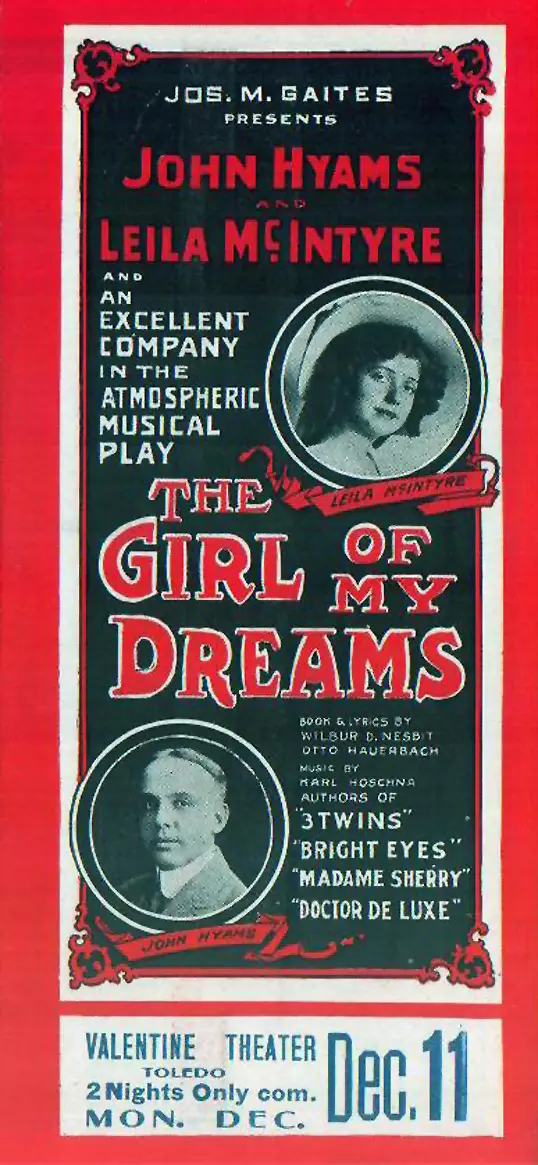 Poster for "The Girl of My Dreams"
Poster for "The Girl of My Dreams"
Ethel Barrymore in "Lady Frederick"
John Barrymore in "Justice"
Maurie Barrymore in "Shenandoah" (featuring a company of 200 including 25 of Roosevelt's Rough Riders)
John Philip Sousa
Leopold Stokoswski directing the Philadelphia Orchestra
Max Fiedler directing the Boston Symphony Orchestra
De Wolf Hopper
Edna Wallace Hopper
Robert Mantell in "Macbeth"
Sarah Bernhardt
Eddie Foy
The Ziegfield Follies (introduced by Oscar Hammerstein)
The Ballet Russe with Nijinski
Al Jolson
Anna Pavlova
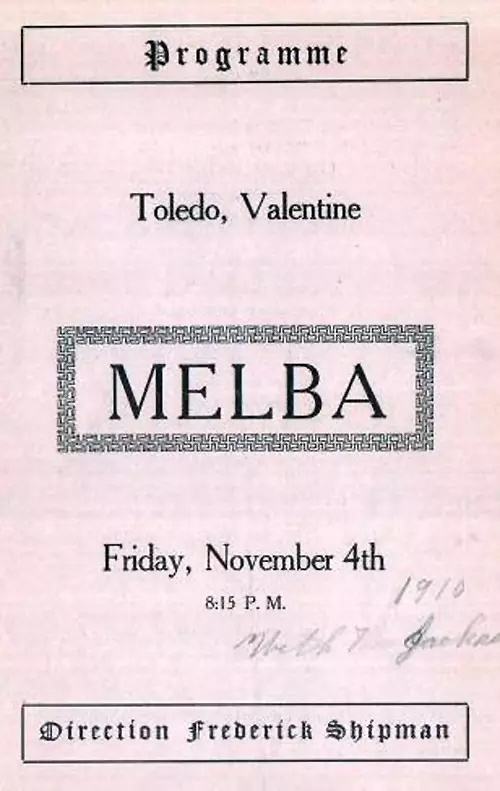 Program for Melba, 1910Jenny Lind
Program for Melba, 1910Jenny Lind
Sothern and Marlowe in "The Merchant of Venice"
Sam Bernard in "He Came from Milwaukee" and "The Rich Mr. Hoggenheimer"
William Faversham in "The Squaw Man"
Robert Edeson in "Classmates"
Richard Mansfield in "Cyrano De Bergarac"
Ezra Kendall in "The Vinegar Buyer"
Otis Skinner in "His Grace De Grammont"
Weber and Fields
Fay Templeton
Peter Dailey
David Warfield
Lillian Russell
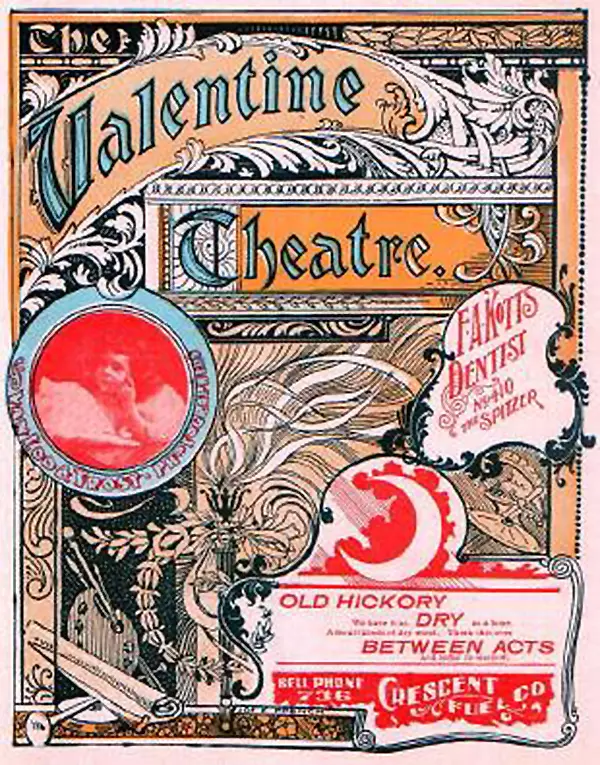 Program of the 1896-1897 SeasonWillie Collier
Program of the 1896-1897 SeasonWillie Collier
Maxine Elliot in "Her Great Match", "Ben Hur"
Montgomery and Stone in "The Wizard of Oz"
Olga Nethersole in "Sappho" and "Camile"
Kyrle Bellow in "Raffles"
Nat Goodwin in "The Genius"
Raymond Hitchcock in "Yankee Consul"
Mme. Schumann-Heink in "Love's Lottery"
Maude Adams in "The Little Minister" and "Peter Pan"
John Drew
William H. Crane in "His Wife's Father"
Alice Nielson in "The Bontonians"
Minnie Maddern Fiske
William Gillette in "Too Much Johnson"
Ada Rehan in the "Taming of the Shrew"
Paderewski
James A. Hearne in his own "Shore Acres"
Belle Theadore
Joseph Jefferson in the "The Rivals"
John Drew in the "Mrs. Malaprop"
William H. Crane
Nat C. Goodwin
Robert Taber
Francis Wilson
Joseph Holland
Julia Marlowe Taber
Fanny Rice
Souvenir program, 1897
Cover of the souvenir issue of 1897, which celebrated the first anniversary of the first production (1896) at Valentine Theatre after its opening in 1895.
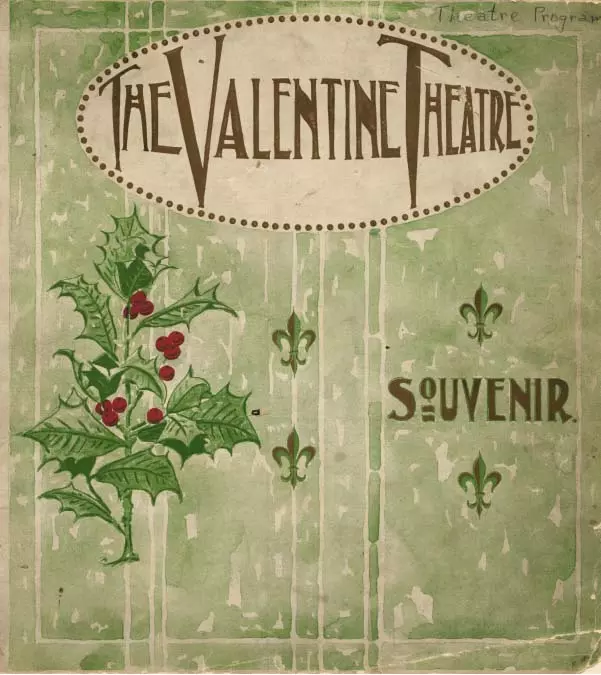 Cover of the 1897 souvenir program
Cover of the 1897 souvenir program

